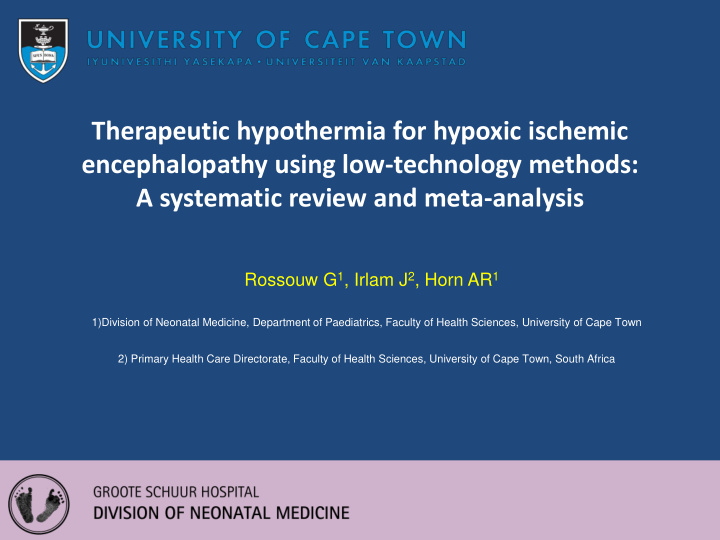



Therapeutic hypothermia for hypoxic ischemic encephalopathy using low-technology methods: A systematic review and meta-analysis Rossouw G 1 , Irlam J 2 , Horn AR 1 1)Division of Neonatal Medicine, Department of Paediatrics, Faculty of Health Sciences, University of Cape Town 2) Primary Health Care Directorate, Faculty of Health Sciences, University of Cape Town, South Africa
Introduction • Decreased death or severe disability at 18 months ( Edwards ,et al. 2010,Jacobs, et al. 2013 ) • ILCOR: should be the standard of care (Perlman, et al. 2010) - In accordance with high quality RCT - Hypothermia must be implemented in intensive care - Most studies used high-technology cooling devices • Several centres use low technology methods • BUT a recent systematic review showed NO reduction of mortality in low and middle income countries (Pauliah, et al. 2013) - Authors speculate low-technology cooling methods inadequate -NB: Studies with no access to ventilation/ICU were included
Objectives • We hypothesised: Neonates with HIE will benefit if low technology therapeutic hypothermia is applied and commenced within 6 hours in an intensive care setting with mechanical ventilation available • Objectives: To systematically review the literature to determine the effect of low technology hypothermia vs standard care in ICU infants with HIE
Methodology • Standard Cochrane methodology (Higgins, et al. 2011) • Written protocol - registered with PROSPERO • Standardised data extraction sheet – two independent authors • RevMan 5.1 software - fixed effects model • Risk for bias was assessed independently by two authors
Inclusion Criteria and Outcomes • Randomised controlled trials: - Low technology hypothermia vs standard care - Low technology: manual application of cooling bags/packs - Therapeutic hypothermia : core temperature < 35 °C • Participants: - newborns ≥ 35 weeks and < 6 hours - nursed in an intensive care environment - objectively defined clinical assessment of encephalopathy - criteria describing intrapartum hypoxia (one of ): - APGAR score of ≤ 7 at 5 minutes or later - pH < 7.0 and base deficit (BD) > 10 mmol/l - ongoing resuscitation for > 5 minutes - history of perinatal event
Outcomes Primary outcome: Mortality (Primary admission) Secondary outcomes: Abnormal neurology at discharge Mortality at 6 – 24 months Mortality or severe neurological morbidity at 6 – 24 months
Search Strategy • PubMed ,Cochrane CENTRAL and Scopus (November 2013) • (P)atient Keywords: “ newborn ”,” infant”, “neonate”, “baby”, asphyxia”, “ischemia”, “hypoxia”, “encephalopathy” or “anoxia” • (I)ntervention Keywords: “therapeutic hypothermia” or “cooling” • Filters: “Randomised Controlled Trial”,” Editorial”,” Letter”, “Clinical trial”, and “Human” • No language or publication date restrictions
Results
Selection of Trials
Included Studies Study n Country Method Target and duration Jacobs, 221 International Soft, 33.5 °C 2011 RCT refrigerated gel for 72h packs Bharadwaj, 124 India Frozen cloth 33.5 °C 2012 covered gel for 72h packs Joy, 2013 116 India Soft 33.5 °C refrigerated gel for 72h packs
Primary Outcome : Mortality Risk of Bias • Overall risk: Low
Quality of Evidence: GRADE approach • Gradeprofiler 3.6 • Inconsistency, indirectness, risk of bias, imprecision and publication bias • High: Further research very unlikely to change estimate • Moderate: Further research is likely to have important impact • Low: Further research is very likely to have an important impact • Very low: Very uncertain about the estimate
Mortality: Meta-analysis Mortality:Primary admission(High quality evidence)
Mortality at 6-24 months High quality evidence
Neurological morbidity in survivors at discharge from primary admission • Bharadwaj, 2012 + Joy, 2013: Amiel-Tyson • Jacobs, 2011: Not sucking feeds at discharge Moderate quality of evidence
Morbidity at 6-24 months • Two studies published data – favoured hypothermia • Data not pooled because of heterogeneity of assessment methods and timing
Adverse Events • No significant differences in clinically important adverse events in individual studies - Mechanical ventilation - Arrhythmia - Hypotension - Bleeding - Sepsis • Substantial heterogeneity in methods
Conclusions • Low technology hypothermia combined with intensive care can significantly reduce mortality (NNTB 13) and reduce morbidity (NNTB 4) in survivors at discharge • Positive outcomes not at the cost of a significant increase in clinically important adverse events in individual studies • Our results are different to those reported by Pauliah in 2013: Emphasizing the environment is more important than the income level • Further research needed to determine the safety and feasibility of therapeutic hypothermia in the absence of intensive care such as low-income countries
Cooling: “It is not about the bike” Thank you
Recommend
More recommend